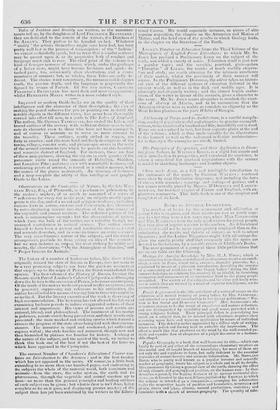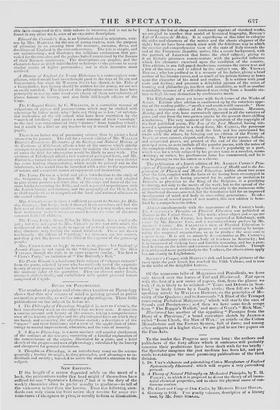Boole; of JUVENILE INereaceioar.
The number of beaks ft ii the amusement find edifiration of :scents fall:.; is so great, and their merits arc now so nivel) supe- 1 ior to what they were a few year; ago, when Miss Enesevoiern :nal Mrs. 11 y1:13AULD Were the only good writers for young people, that Ihey almost regnire a renew' to tbeinselves. An Educational Per.oilical could mat be more appropriately employed than in dis- criminating' the merits and delacts of nursery as well as school litetature ; and the Ladies' Magazines might m h advantage dis- pleat! the uataby-pamby stuff that commonly tills the space not devoted to the faaLions, by a sensible review it' Children's Books.
The most prominent of a group of these little publications that are on our table are the fofIo.,ving.
tlicainas,aar An:using lawariefae, by Miss 1 1. .T. WOOD ; which is nil entertaining miscellany, consisting of tam elementary treatise on conch- ology, a visit to Paris, moral tabs, dnunatie proverbs, Sze.; connected by means of a pleasant introduction. describing the reunion of a community of residenN in '' the 1 hippy Valley" during the Alid- summer holydays, to celebrate Coe recovery of an invalid, by furnishing occupation and amusement of an instructive kind to the young people assembled. The variety of the subjects, and the clear and lively man- ner in which theyare treated by a miad of superior intelligence, are its recommendations.
Female Liqworement is the title and object of a series of essays on the crhuatlull 4111:1 mental training of young Indies, by Mrs. SANDFORD ; and intended as a sort of introductinn to her former publication," Wo- man in her Social and Domestic Character." Airs. SANDFORD'S ob- servations appear to ha the result of experience and mature reflection, and are distinguished by amiability and good sense, pervaded with a strong religious feeling. Their principal defect is generalizing too much on a subject that, to be treated with advantage, requires close reasoning upon facts and vigorous application by means of individual instances. This detect is rather aggravated by a diffuse style of writing, whose very polish and fluency tend to enfeeble the impression. The effect is much like that produced on the mind by the well-rounded pe- riods and equable flow of eloquence of a pulpit discourse in a fashion- able chapel.
Popular Geography is a book that well bears out its title,—which can hardly be said of any other of the compendious elementary treatises on this useful and ill-taught branch of knowledge; for most of them are not only dry and repulsive in form, but sadly deficient in the essential requisites of comprehensive and accurate information. Mr. Roweaen Boeu, who is pretty well known as a popular lecturer and scientific teacher of geography, treats his subject as a whole and in all its details. I le tommences by taking a general view of the earth, showing the effect of soil, climate, and geographical position, on the human race : he then describes separately the leading features of its various territorial that- sit:us—as delineated in the neatAtlascs published by THOMAS, to which the volume is intended as a companion—arranging his information 'elder the respective beads of position and boundaries, mountains and Plains, rivets and 'elkes, climate, natural productions, statistic's; and eencludo with a sketch of ancient geography. The quantity of valu- able facts comprised in this little volume is immense, and is not to be found in any other work, even of an expensive description.
Edward the Crusader's Sun, is an historical novel in miniature, writ- ten by Mrs. Bsuweas. for the use of young readers, with the purpose of picturing ill all ;tilising form the manners, customs, dress, and dwellings of England in the eleventh century. The tale is simple, and not uninteresting ; and illustrates the religious enthusiasm that pre- vailed for the crusades, and the jealous hatred entertained by the Saxons of their Noonan oppressors. The descriptions are graphic, and the characters have as much individuality as belongs t) the persons in inany similar works of higher pretensions; our is their discourse more artificial.
A History of England for Young Historians is a commonplace com- pilation, which wool(' have been thought good in the days of lit not and Comesstan, but since Sir WALTER Steers has shown, in his Tales tf a Gran/fir/her, how history should be written fiw the young, we are not so easily satisfied. The object of this publication seems to have been principally to use up some wood-etas (many of them very inferior), of places fatuous in history, and also little full-length effigies of the kings.
The Colloquial Cobh?, by C. Winisms, is a corrective manual of vulgarisms of phrase and prommeiation, which may be studied with advantage by ladies' maids who "hate any thing as is low," or substan- tial tradesmen of the old school who have been overtaken by the "march of intellect," and prefer a mute monitor of their "eacolog,y" to the vivii core corrections of their "darters" from boarding school ; but it would be a libel un any teacher to say it would be useful to his pupils.
There is no better way of promoting science than by giving a local interest to its pursuit. The call for a moored edition of Mr. Witeeest Rio e 11 5 Ercacsions Ilkstratice 4:1. iGc Ccuh■op and Natured History if the Eacimus Edinlairyli, affords a hint of the success which similar attempts to popularize natural science by making the neighbourhoods of cities the field for observation would be likely to meet with. The environs of Edinburgh afford it rich vlriety of geuh.gical facts, and Arr. Rolm) has turned these advantages to good account : but every district has same leading characteristics, which ndglit be pointed out to the inhabitants, who would thus be furnished with a clue to the operations of nature, and a constant source of enjoyment and instruction.
The Young Divine is a brief and plain introduction to the study of the Scriptures, by the Reverend IV. Eiserenen ; very well adapted to give young persons a distinct idea of the stop and tenor of the va- rious hooks co:noosing the Bible, and such a general acquaintance with the Jewish history and customs, and the geography of the Iloly Lind, as shall enable them to comprehend the local and national allusions in the sacred volume.
Mrs. t 1111.o's neme is shelf a suffrient passport to Stories Sbe Ifuiq- deg Ecenau;s ; but haivie look,41 through them oursekes, anal nd NO the best test of their ainesiee finalities supplied by a young reader, we can bear testi:limey to rieic nwrifs Os mural lessons cm sonic of the most common fault, ut ellibleco.
The Yalu!, Liol's Stry. Teller, by Miss Lusters has it s:miler oh- feet ; Ina it is not «etel to Mrs. Citii.D's iu tit tract with which the im.idents of the tale ::re made to app,,ar of mtural occurrence, while they illuAnitc very forcibly the mood These are drawn too broadly : the effects of " tattling," f.Ar instimee, are too serio;:c, and they point the lesson to the child at the eN,,o2nse of the grown-up people.
Mrs. Cabin is not sa ha] py in verse as in prose : lice Gorked rf Juvenile Puems is not equal to the "Original Poems" of the '1'AN-1.011S, though the style is in $ome respects similar. The best is " Flora's Party," an imitation of " The Butter fly's The Poetic 11, cad, is a handsome Effie volume of "elegant extracts" from the poets, selected by one who has evidently tasted the exquisite beauty of every passage, and has had no other guide for his choice than the intrinsic value of the quotation. They are clan-soil under heads, arranged alphabetically, and embellished with quaint pictorial letters composed of Cupids.



























 Previous page
Previous page